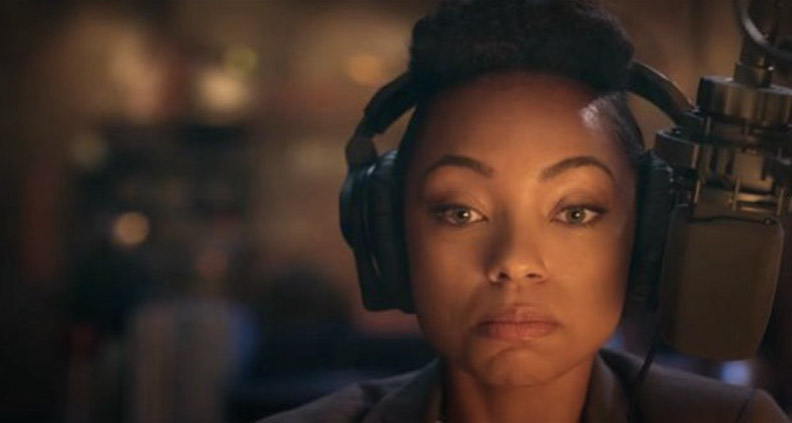In addition to taking home prizes at several top festivals, the film also scored a Film Independent Spirit Award for Best First Screenplay. Simien then quickly set about reimaging the project as a TV series, something the 33-year-old filmmaker says had always been his intention for the story, centered on firebrand college DJ Samantha White (played by Tessa Thompson in the film) and the various students and administrators in her orbit. Fast forward to now: starting today, all 10 episodes of Dear White People’s first season are being released on streaming giant Netflix. The show picks up right where the original film left off, with Logan Browning stepping in as White with a supporting cast including Brandon P. Bell, John Patrick Amedori and Giancarlo Esposito (who voices the show’s narration). We recently chatted with Simien—in the midst of a busy press blitz—about how his breakout feature found its way to the small screen, the evolution of the project’s approach to race, and what makes for a good film-to-TV adaptation.
JUSTIN SIMIEN
How did Dear White People go from being this successful indie film to being adapted for Netflix? Simien: It was really organic, man. When I was going through the process of refining the movie into something we could shoot with the budget and resources we had [at the time], a lot of stuff had to go. Characters had to go, storylines had to go, scenes had to go. So I went into the movie already feeling like there was a lot of stuff that didn’t make it into the final film that I wanted to explore. Lionsgate Television brought me in for a meeting just to see if [adapting the film for TV] was something I was thinking about. It just so happened I was thinking about it a lot. We just took that pitch around the industry. We had a bunch of bidders, and eventually landed at Netflix. For the show you’re working in the same world using many of the same characters as the feature, but several of the parts have been recast. Did that change your approach at all? Simien: Not really, because we were already a few scripts in by the time we were choosing the cast. I was looking for people who weren’t going to do an imitation of what the actors before them had done, but who were going to use that as a starting point to riff in their own style. We were out to the original cast, of course, but there were just a ton of conflicts there. Once we knew Tessa wasn’t coming back, we had to find Sam. I don’t think of her as the “lead” of the show, I do think of it as a truly ensemble show, but she’s at the center. So that person had to be a knockout. When you’re building an ensemble, it’s not just about how great [the person] is as an actor or how great they look. They have to have a dynamic with each other that’s compelling. That’s why we watch TV shows, because of the dynamics between the characters. So the rest of it grew from there. You started working on the idea for Dear White People back in 2007. So as a whole, this project has now bridged the entire Obama era. How is your thinking about these issues different now as opposed to what it was 10 years ago? Simien: I was in my senior year in college, 2005. I’m having lunch by myself and for whatever reason a title sequence flashed into my head with all the characters. That original lightening bolt of inspiration morphed into many things, as it often does, but the TV show is a lot closer to what I had originally envisioned. I wasn’t working on it non-stop. I picked it up and I put it down and it always meant something a bit different as the culture changed. The conversation has shifted in this country quite a few times. When I first started writing it, there was no such thing as racism. You couldn’t even bring up racism; you were a crybaby, you were crying wolf. Now the show is coming out in an era where hopefully people are awakening to the fact that systemic racism in this country has global consequences. How is writing and directing for TV different than writing or directing a feature film? Simien: I always wanted the show to be cinematic. From the start, I wanted to shoot this like a movie, with guest directors in-between. That was the mantra. The writing part was in a lot of ways easier and in a lot of ways harder. With a movie, you have a contained document that everything builds into this one moment where the theme of movie just explodes in the minds of the audience. That’s the goal of a screenplay. But with a TV show you don’t necessarily have to have that moment in every episode. You have a lot more freedom in terms of the rules and structure, but the hard part is maintaining a global plot while also making each individual slice just as compelling.
Do you have any favorite movie-to-TV adaptation? Simien: I think Fargo is really great. They set the bar really high. It’s a classic, but MAS*H made a really great transition from film to TV. I will say that some of the broadcast attempts, in my opinion, haven’t really been as successful. But I’m into Fargo, for sure. They’re just killing it—literally. What does Dear White People need to do as a TV show in order for you to consider this experience a success? Simien: I already feel like it’s a success, to be honest. I feel like I got to make exactly what I wanted to make. I’m really proud of it and it’s already sparking conversations. I feel kind of anxious moving into our premiere date, just because I don’t know what to expect, but I don’t feel like anything is hinging on anything. In terms of the culture, hopefully it’ll inspire conversations and spark new TV shows and paradigms. But I feel like I already won, I really do. https://www.youtube.com/watch?v=oYKgHvPVACE All 10 episodes of Dear White People’s first season are available beginning April 28—that’s today—on Netflix streaming. To learn more, visit Simien’s website or Facebook page. Become a Member of Film Independent today by clicking here. And don’t forget to follow us on Facebook, Instagram or Twitter. Also, be sure to subscribe to our YouTube channel.

